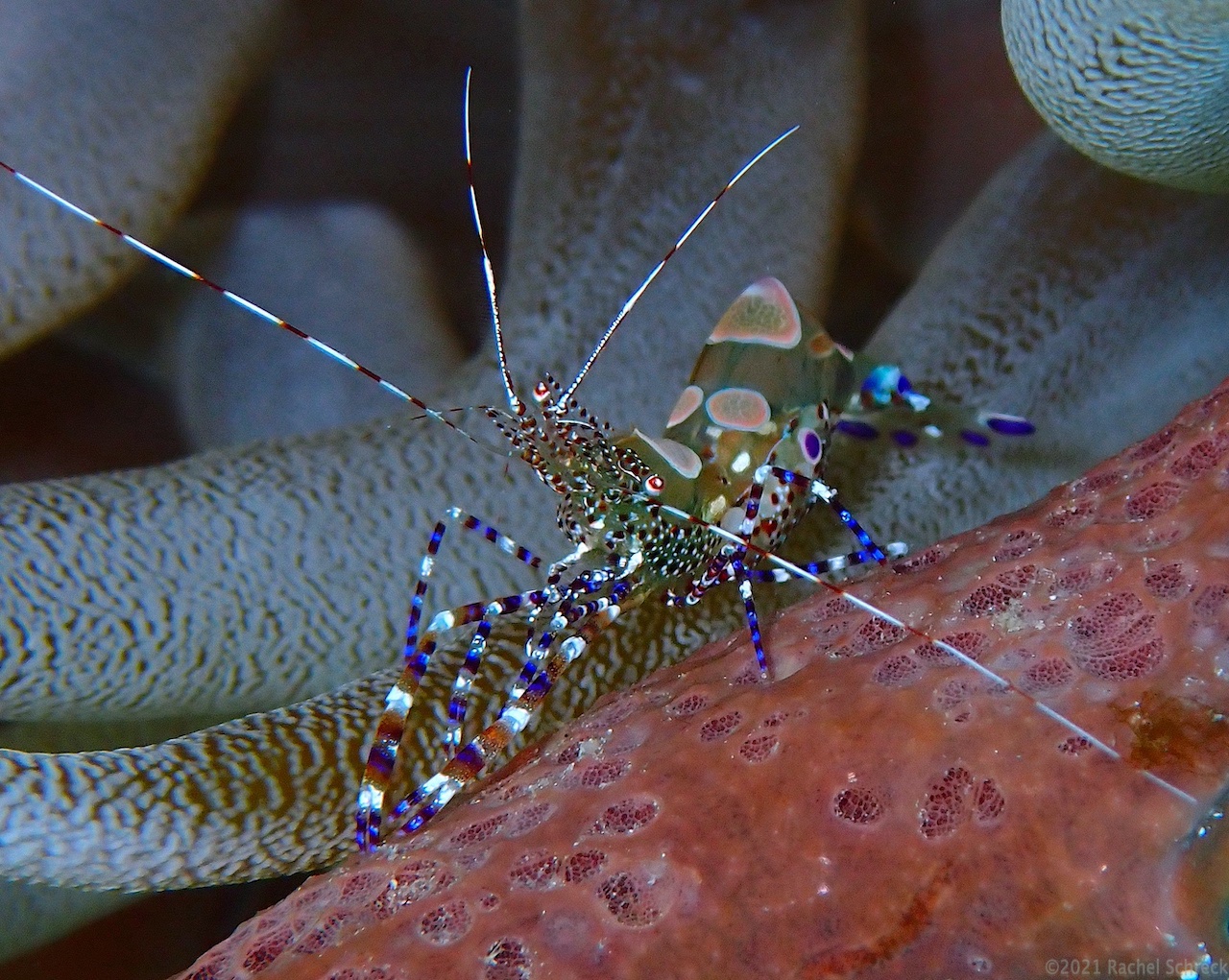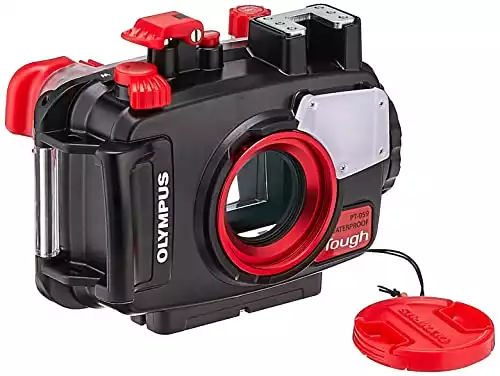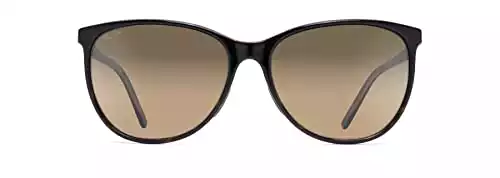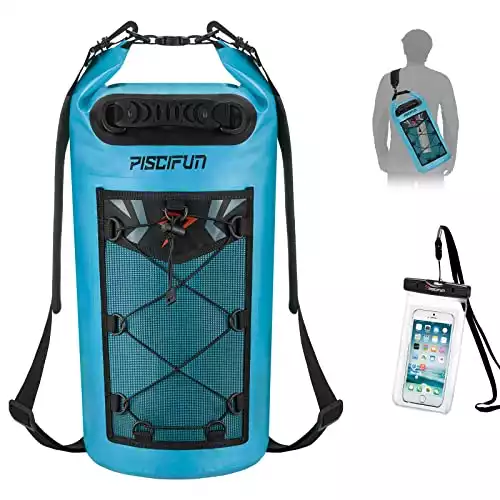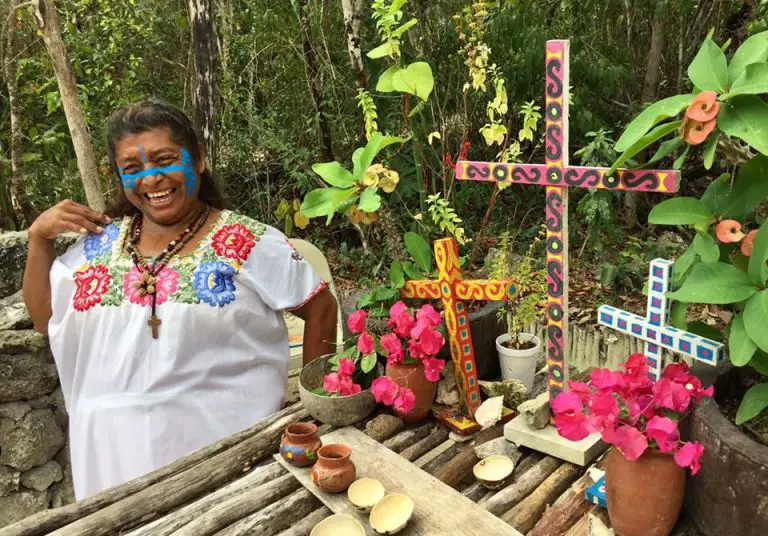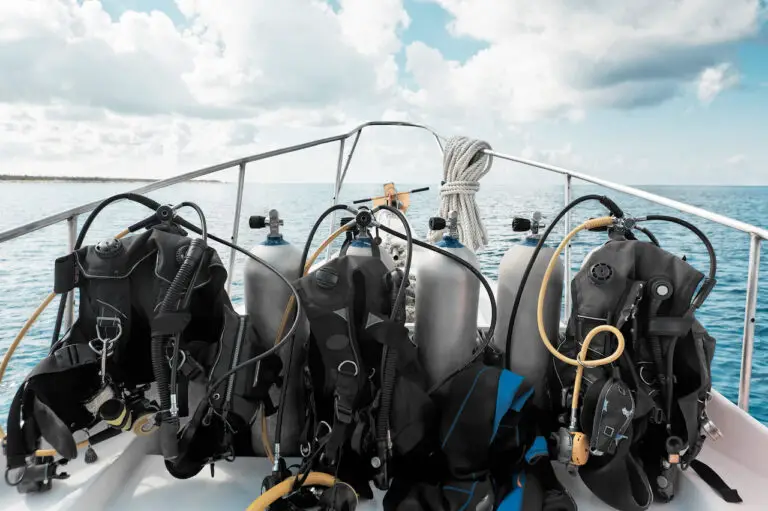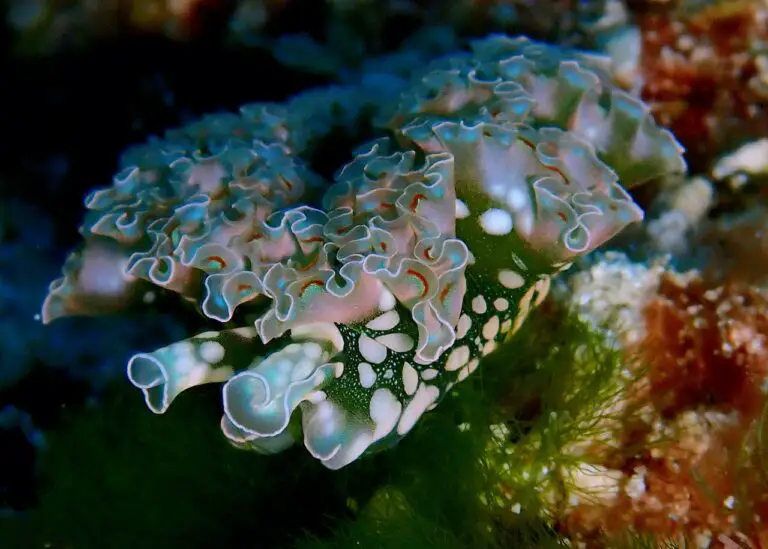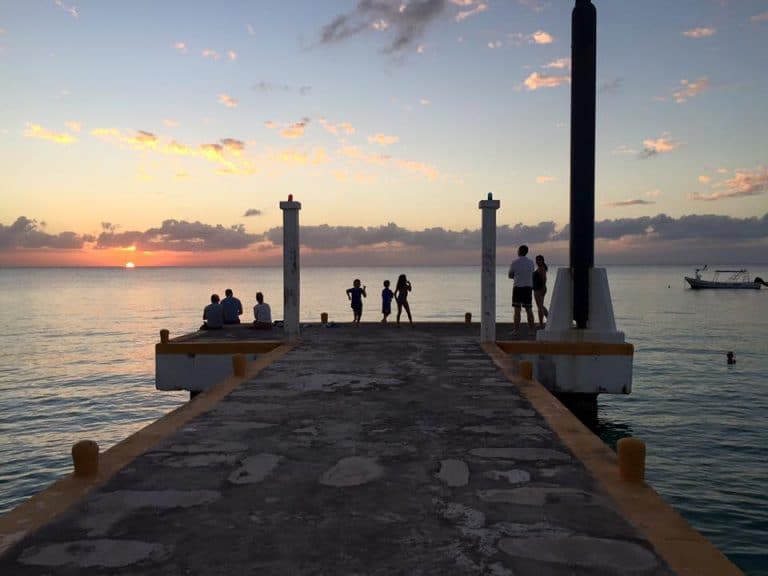Cozumel Macro: Colorful and Ornate Shrimp
In the not-too-deep, glass-clear waters of Cozumel, Mexico live thousands of tiny treasures for divers and underwater macro photographers: an array of brightly colored marine shrimp that make perfect dive photo subjects.
These tiny critters are a sight to behold…once you get good at finding them. And not scaring them away!
Macro marine shrimp come in various shapes and (small) sizes, from bright red to electric blue.
They move purposefully, going about their important task of cleaning their host and a constant parade of “client” fish, and they are fascinating to watch.
These shrimp species seen while scuba diving in Cozumel are not just beautiful; they are also incredibly photogenic. With their vibrant colors and unique shapes, they make for stunning photographs. So whether you’re an amateur or professional photographer, these shrimp will make your pictures pop.
Cozumel is an excellent place to find these photogenic shrimp. The reefs around the island are teeming with them, so you’ll have plenty of opportunities to capture them on camera.
Just be sure to bring your underwater camera, a big memory card, some extra batteries – and an eagle eye! You won’t want to miss out on capturing these cool creatures.
The “Popcorn” Shrimp of Cozumel
The most ubiquitous marine shrimp to see while diving in Cozumel is the squat anemone shrimp (Thor amboinensis).
Also known as popcorn shrimp or sexy shrimp, this shrimp species in Cozumel is typically dark reddish-brown, with white markings, orange legs, and some bioluminescent blue lines around the white spots.
While beautiful, they’re so tiny a lot of people don’t know they’re there, or just can’t see them clearly without bi-focals in the dive mask.
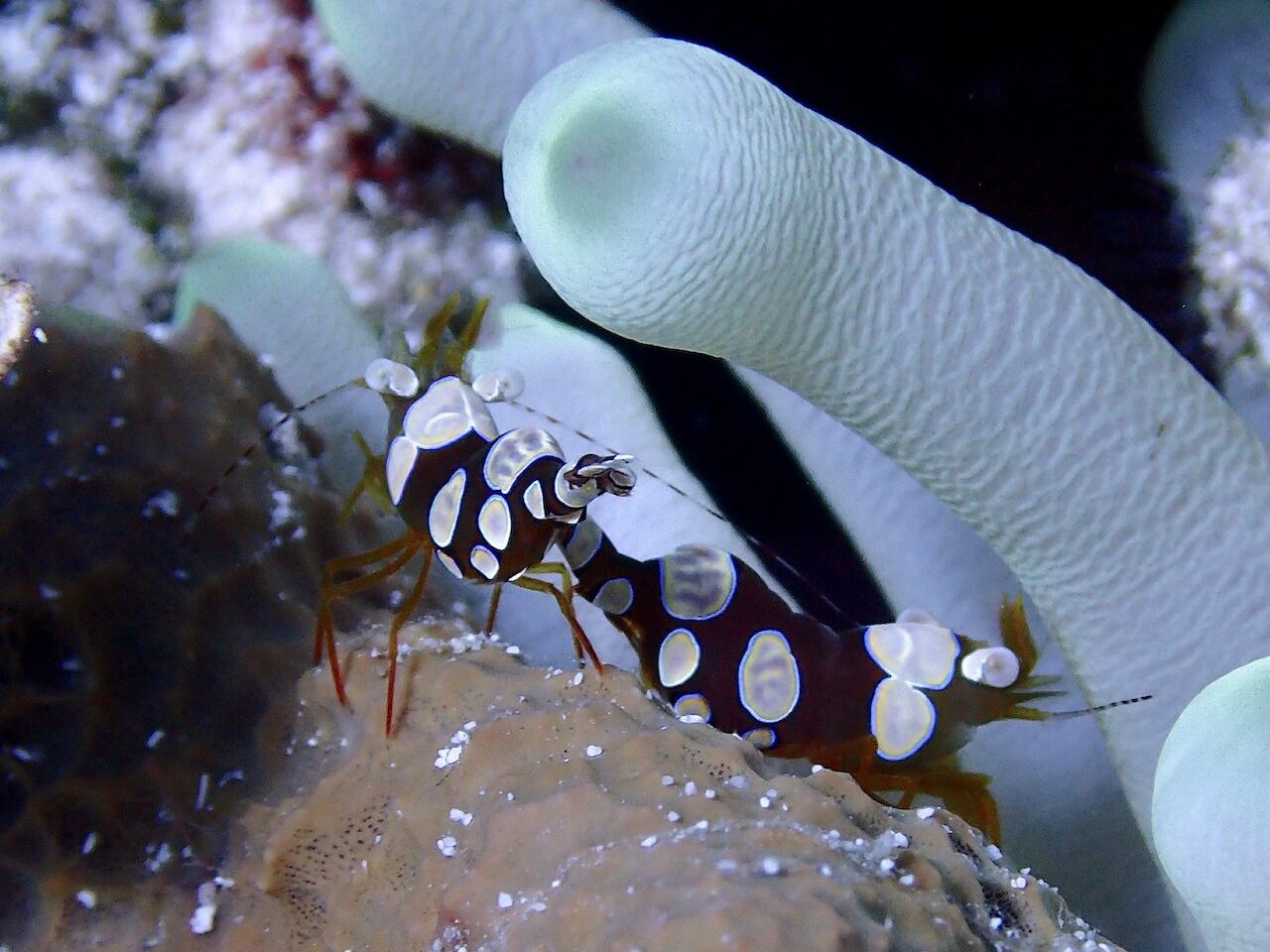
Squat anemone shrimp are found in clusters or little colonies, and you’ll often see anywhere from a few to 20 or 30 of them hiding out behind the folds of anemones and adjacent nooks and crannies on the reef.
These shrimp are plentiful on all of Cozumel’s dive sites; I’d bet you’ll see them on every single dive in Cozumel.
They’re not the most accessible photography subject, though, especially for beginners.
Squat anemone shrimp move around a lot, do not like you to get to close, and if you do, they scatter in a split second.
Their markings – while beautiful – also make it hard to get a good crisp shot.
If you use too much light, the UV blue and white spots come out overexposed, but with no flash or strobe, the resulting images are often dull.
Getting great images of squat anemone shrimp in Cozumel is a good challenge, but if you’re just starting out with underwater photography, try to identify some easier subjects and get some early, confidence-building shots before tackling these guys.
Banded Coral Shrimp
The banded coral shrimp (Stenopus hispidus), also known as the banded cleaner shrimp, is one of the easiest marine shrimp to photograph while diving in Cozumel, Mexico.
Banded cleaner shrimp are found all over the coral reefs, mainly living inside purple sponges. They often live in pairs and the contrasting white and red bands on their large front claws, along with their bright white antennae, make them stand out amongst the other sea life.
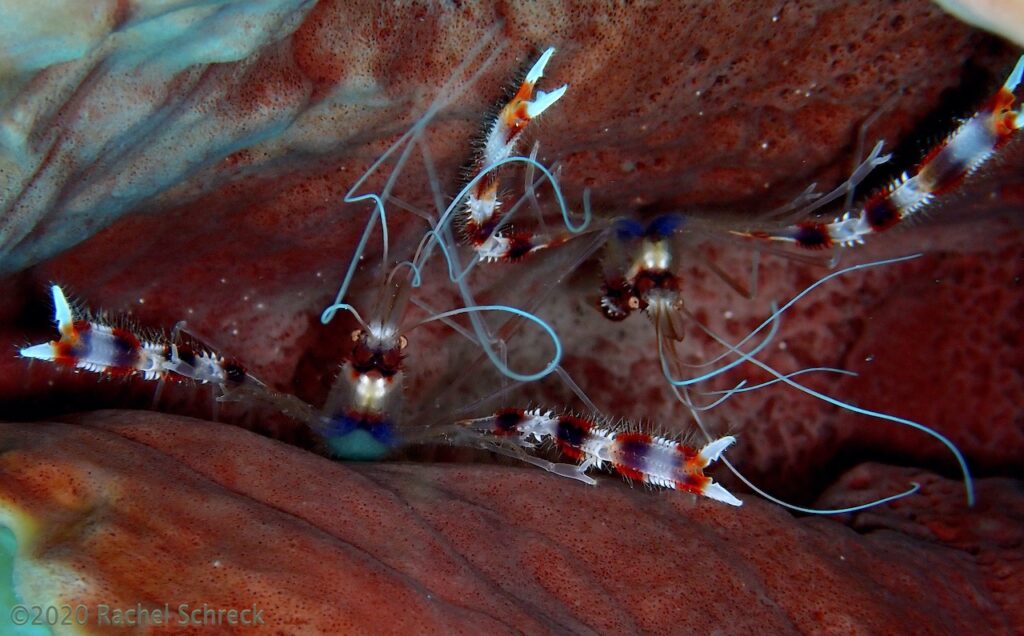
Banded cleaner shrimp have an essential role in the reef ecosystem. They clean debris and parasites off of moray eels and tropical fish of various sizes. This small but crucial service keeps the marine life healthy and the reefs vibrant.
Underwater macro photographers in Cozumel can find them easily by looking for their brightly colored bodies and long antennae poking out from their hiding spots.
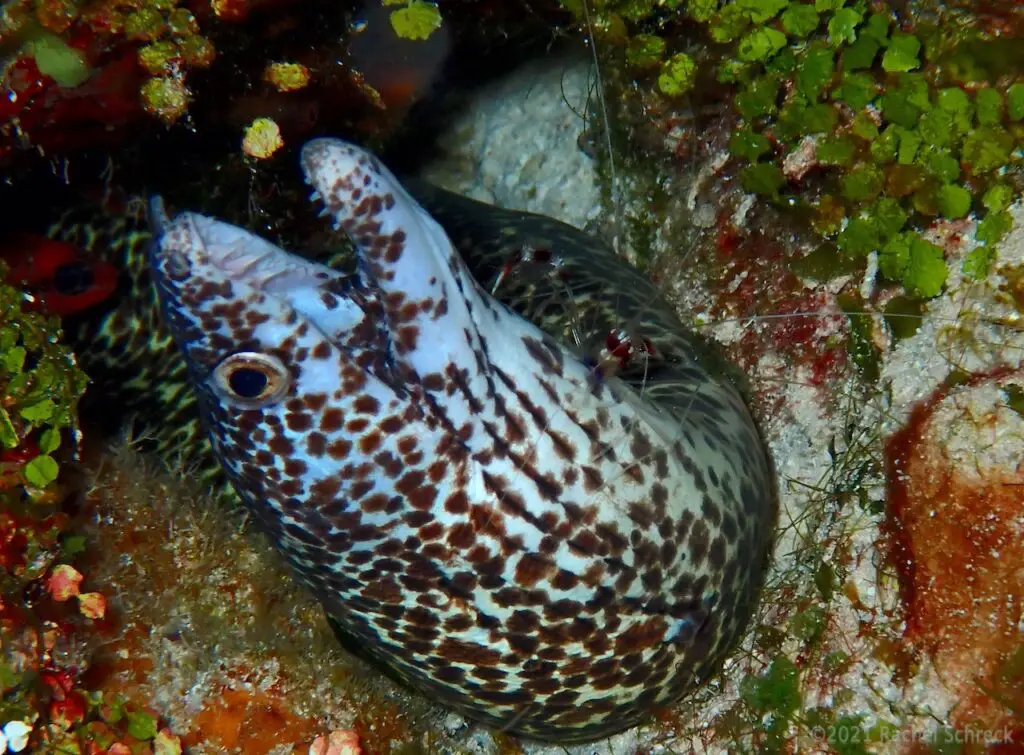
Spotted Cleaner Shrimp – Common and Captivating
The Spotted Cleaner Shrimp (Periclimenes yucatanicus) is one of the more ornate shrimp underwater macro enthusiasts will encounter while diving in Cozumel. Luckily it’s also one of the least bashful underwater macro subjects in Cozumel.
This shrimp tends to hang out individually and has no turf wars with the previously mentioned popcorn shrimp.
Spotted cleaner shrimp like to inhabit anemones and have a symbiotic relationship that helps keep the anemone healthy.
The anemone provides the cleaner shrimp with a safe place to live, and the cleaner shrimp cleans the anemone’s mouth and tentacles, so it stays healthy. In return, the anemone provides the cleaner shrimp with food in the form of leftover scraps of food from other marine life.
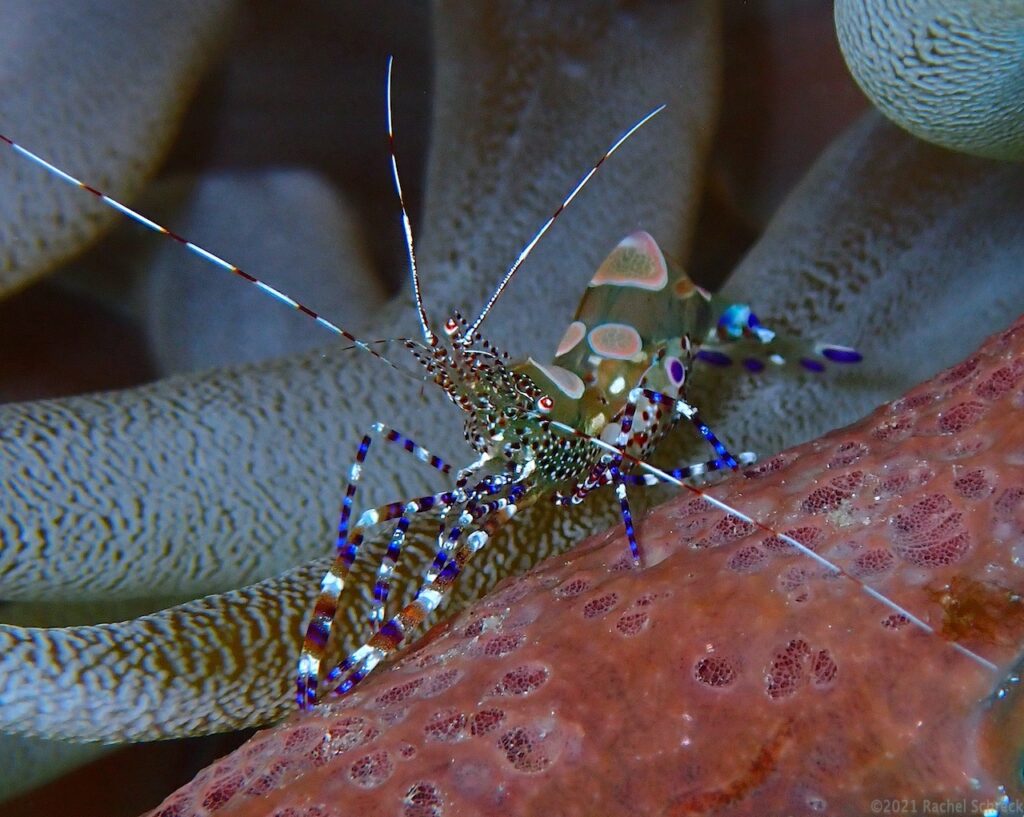
The spotted cleaner shrimp is gentle and non-destructive to the anemone, but they will put on a good show and charge at intruders who try to crash their party.
As a giant human, it’s funny to see a minute little shrimp come scrambling out onto one of the anemone’s arms as if shaking a (delicate) claw and yelling at me to get off its lawn!
But, realistically, it’s more likely that the cleaner shrimp thinks I’m another “client,” namely a big fish coming to get cleaned of parasites and other debris.
These shrimp will approach their clients and begin to groom them. First, the cleaner shrimp will rasp away at the fish’s body, removing parasites and dead skin. Once the larger creature is clean, the cleaner shrimp will move on to the next or recede into the safety of its host anemone.
Fish gets cleaned, and shrimp gets food (and shelter). Win-win.
But for divers and photographers, the cleaner shrimp’s bolder behavior makes it much easier to take a spotted cleaner’s underwater portrait.
Unlike most marine shrimp I’ve encountered, their confronting approach often allows for a clean shot at a lovely image of a posed specimen without getting too close to the reef and possibly touching anything.
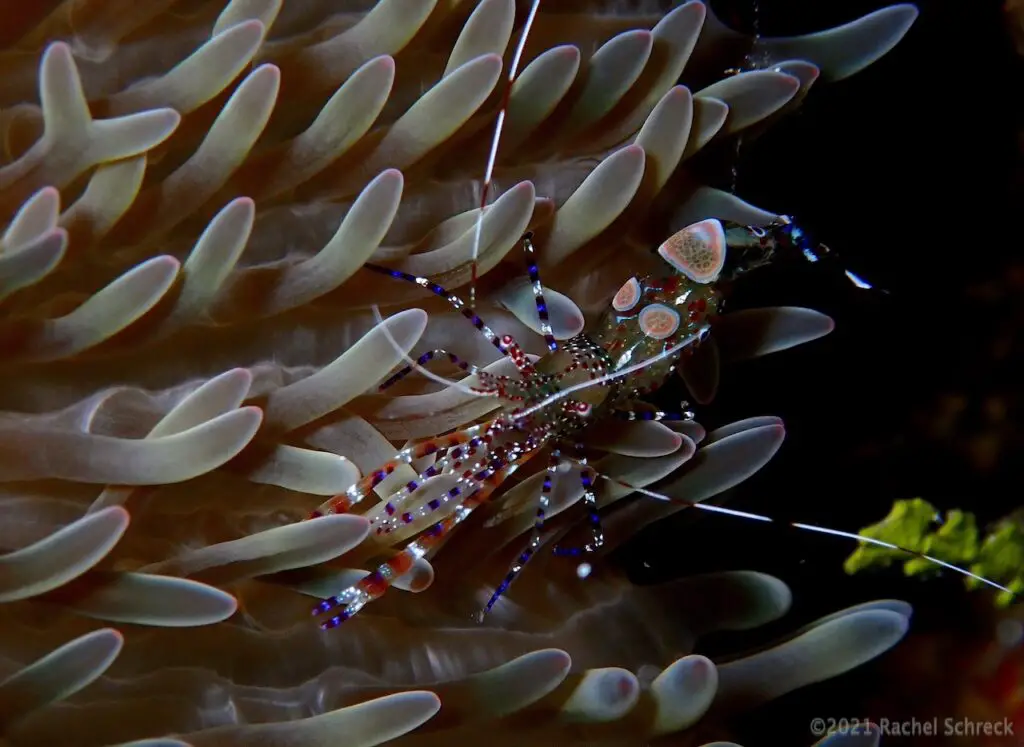
Sun Anemone Cleaner Shrimp
The sun anemone cleaner shrimp (Periclimenes rathbunae) is a relatively rare find when diving in Cozumel.
The cleaner shrimps spend most of their time hanging out specifically around sun anemones.
First of all, what is a sun anemone?
Sun Anemones in Cozumel
The sun anemone (Stichodactyla helianthus) is a beautiful, low-profile anemone species found predominantly in the Caribbean. There are several here and there along the reefs of Cozumel, Mexico. Sun anemones feature a unique greenish, blue and purple coloring, with shorter tentacles than other anemones.
Sun anemones look more like small round patches of shag carpet, so are sometimes familiarly called a “carpet anemone.”
The sun anemone itself is also very easy and fun to photograph, so even novice divers can capture stunning pictures of this beautiful creature.
I often take closeups of the sun anemone, whether a shrimp is in there or not!
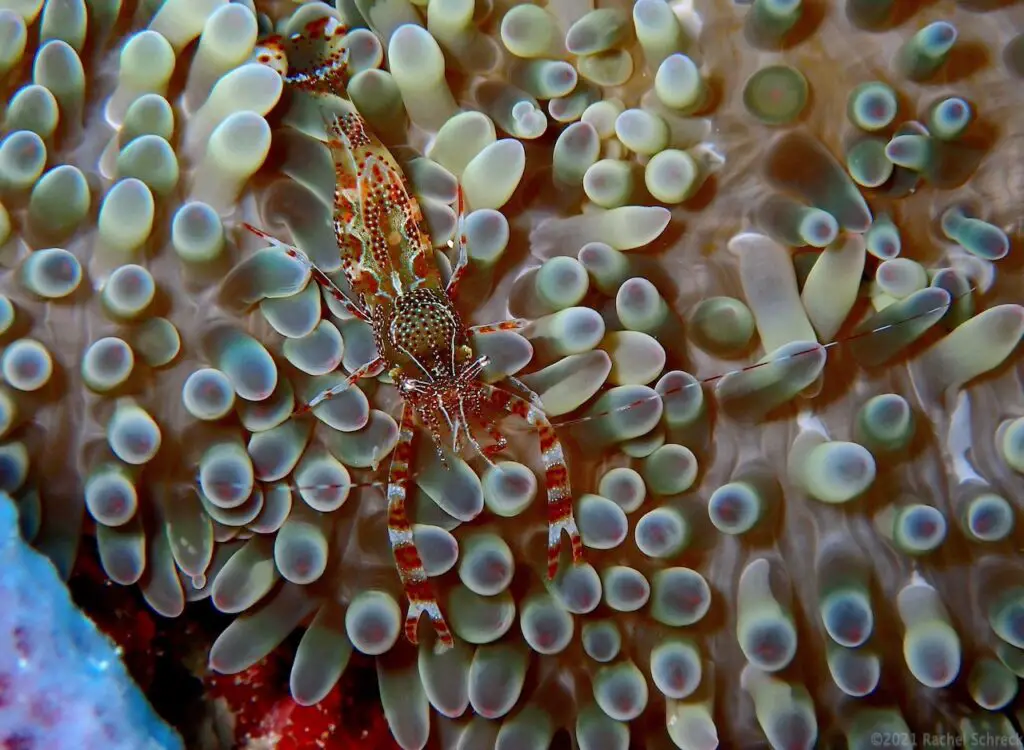
But it’s much better when you can find a sun anemone shrimp.

Sun anemone shrimp clean the tentacles of the anemones like their spotted cousins but tend to stay more tucked into the sun anemone’s shorter arms or hidden behind the main stalk of the anemone itself.
The sun anemone shrimp also has intricate markings and colors, more in the range of orange, yellow and browns – kind of a tawny version of their spotted cleaner cousins.
Pederson Cleaning Shrimp
Pederson Cleaner Shrimp (Ancylomenes pedersoni) are similar in color to the spotted cleaner shrimp, above, and it’s easy to mistake them, especially when you’re first learning about them and practicing your underwater macro photos.
Once you get closer and learn more, however, you’ll instantly notice their unique blue markings, and that they’re much smaller and fainter in stature, with long front arms that typically stay extended out in front of the animal. See below.
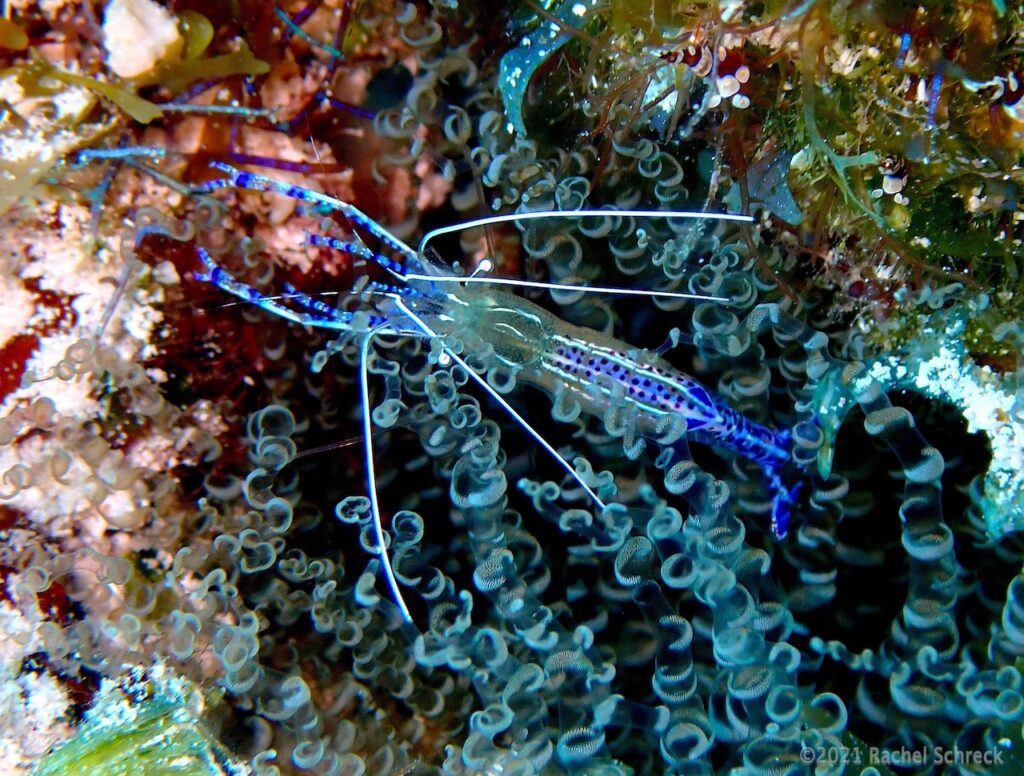
Pederson Shrimp can be found anywhere, but their most common hideout is yet another kind of anemone in Cozumel – the corkscrew anemone (Bartholomea annulata).
Scarlet Cleaner Shrimp
Scarlet cleaner shrimp in the Caribbean are beautiful but much trickier underwater photo subjects. This type is definitely the one I’ve seen the least in my thousands of Cozumel dives, so I get pretty excited when I encounter them.
These little guys get their name from their color – they have this bright deep red section along their back and a vibrant white stripe along their body length.

These slightly smaller cousins of the spotted cleaner shrimp tend to be tucked into the coral reef and found up under ledges and overhangs where they can watch fish pass by safely and remove them of parasites and other debris once their clients approach.
Unlike their spotted cousins, scarlet cleaner shrimp don’t charge at intruders who try to crash their party. Instead, they stay tucked into their small ledges or crevasses in the reef, making them much harder to find, never mind to photograph.
Mantis Shrimps in Cozumel
Mantis shrimp are really a whole other class of marine shrimp, but they are terrific (and challenging) Cozumel macro photo subjects.
Mantis shrimp typically come in larger sizes than the cleaner shrimps discussed above, but unfortunately they’re more shy and skittish.
But with a good eye and patience, you can get that perfect image.
The three main types you might encounter (if you’re a really good scout or you get lucky) are the dark mantis shrimp, the scaly-tailed mantis, and the (related) red-orange ghost shrimp.
Dark Mantis Shrimp in Cozumel
Dark mantis shrimp (Neogonodactylus curacaoensis) in Cozumel are all over the reefs, often found in corals and rocky areas or patches of sea grass, where they blend in seamlessly.
Mantis shrimp are known for their powerful defensive punch and their unique eye-stalks and powerful eyes.

Dark mantis shrimp spook easily, though. If you happen to glimpse one out of its hiding spot, it will appear a dull olive drab color. That is, in the split second before it zooms back into a dark crack or hole. If you can hang out for a minute (but still stay with your group), you might see the shrimp peek out and consider emerging again, but typically they remain good and hidden.
Scaly-Tailed Mantis Shrimp
These white-to-yellowish scaly-tailed mantis shrimp (Lysiosquilla scabricauda) dig amazingly precise, round tunnels into the sand, so if you see a clean round hole? Chances are there is a timid scaly-tailed shrimp down there.
They are typically shy too, so if you’re lucky enough to catch a glimpse of one sitting atop its burrow, presumably waiting for a snack to float or wander by, approach very calmly and gently.
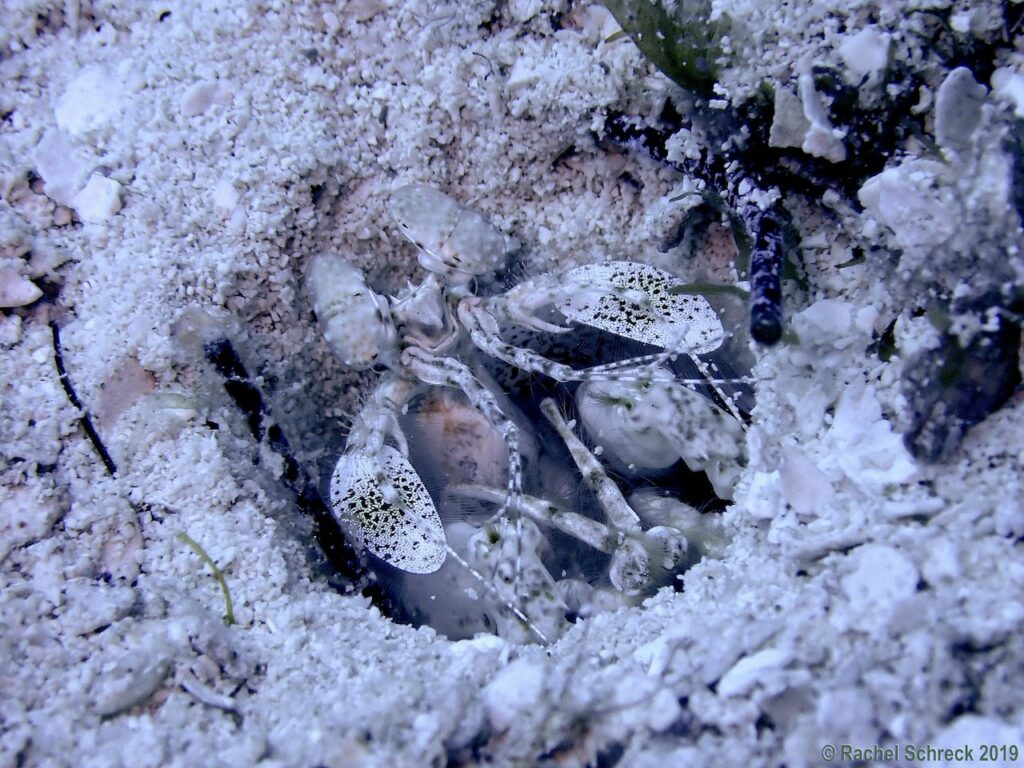
Hopefully you can shoot a few frames in focus before it darts back down into the tunnel, where it will usually stay until you’re long gone.
Red-Orange Ghost Shrimp in Cozumel? Look Down.
I was sure this was a close relation to the scaly-tailed shrimp, because these red-orange ghost shrimp (Corallianassa longiventris) have the same burrowing behavior, and they too sit atop their holes until easily startled back down into the safety of the tunnel.
But, they are not in the “mantis” category, after all!
I think it’s the lack of large eye stalks, and different size and shape of the front claws, etc. I’m leaving it here, though, because if you’re a Cozumel scuba diver, finding these two are closely related.
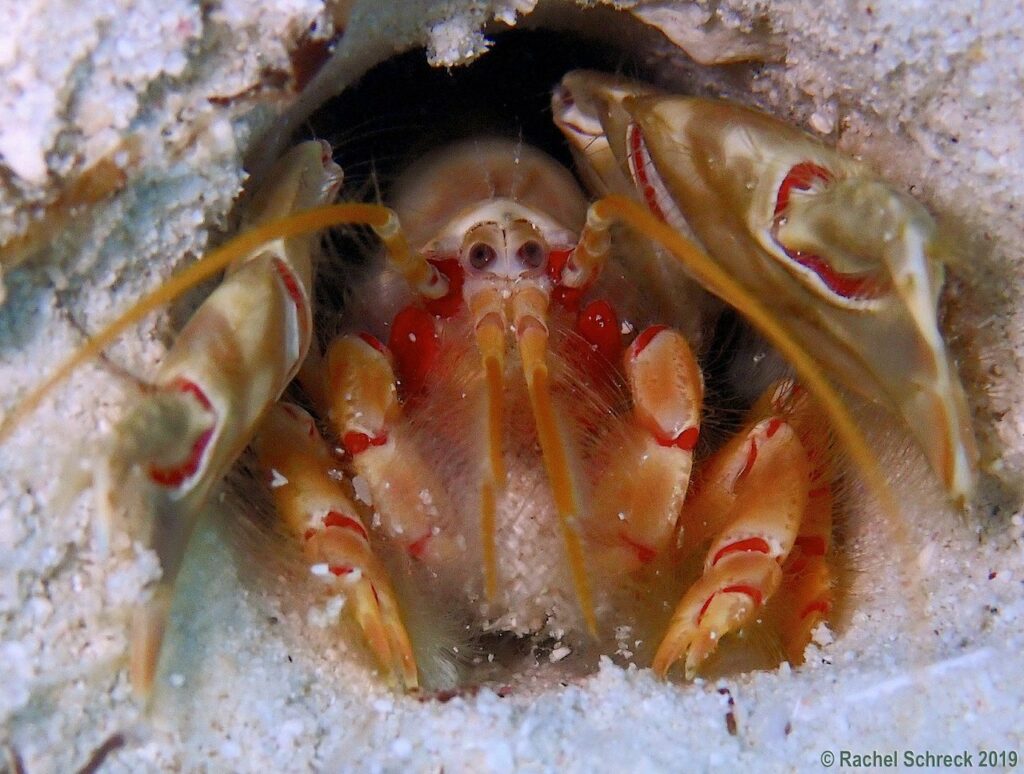
But when you’re diving, they will be on the sandy ocean floor, just like the scaly-tailed ones, so look down, and do a similar cautious approach if you’re hoping to get a good shot.
FAQs Photographing Macro Marine Shrimp in Cozumel
1. What is the best time of year to observe and photograph marine shrimp in Cozumel?
The warm, clear waters in Cozumel make it possible to spot and photograph these creatures all year round.
2. What type of camera equipment is recommended for photographing marine shrimp in Cozumel?
The best way to photograph marine shrimp in Cozumel, Mexico is to use a camera with a macro lens and a strobe or flash. The type of camera you use is up to you and can depend on your budget and skill level.
3. Are there any special techniques for capturing the most photogenic shots of marine shrimp in Cozumel?
To get the best shots of any macro subject in Cozumel, practice your diving skills and buoyancy control to ensure you can control your position in the water column and keep steady before approaching too closely.
Then, gently and slowly ease close enough to capture the details of these animals. Additional tips are to be patient and practice on easier subjects so you can cultivate a keen eye for the perfect underwater shot.
4. What are some of the best spots to dive for photographing marine shrimp in Cozumel?
Cleaner shrimp are some of the most photogenic marine life to photograph while diving in Cozumel, Mexico. They are commonly found on shallow dives around 30 – 50 feet deep, making San Clemente, Santa Rosa Shallows, and Yucab ideal dive sites for capturing these creatures.
Mantis shrimp in Cozumel are all over the place, and as mentioned above, the white scaly-tailed mantis and the orange ghost shrimp are almost always spotted at the top of the deep round tunnels they burrow in the sand. So look down, occasionally!
5. Are there any safety precautions to consider when photographing marine shrimp in Cozumel?
Don’t damage the reef or touch any coral or anemones in the name of getting your shot. If the current is too strong, or your buoyancy is still getting dialed in, hold off on any dive pictures that require you to get too close to your subject.
Fore more on Cozumel marine life and macro photos to look for, consider some tips in this related post about great macro subjects for beginner underwater photographers in Cozumel.
Or jump to the big stuff, and read more about Cozumel’s marine life in these posts:
Cozumel’s sea turtles – full overview
What types of moray eels are in Cozumel?
How about sharks? Can you see sharks while diving in Cozumel?
- Easy to use
- Easy to pack
- Easy on the wallet
- Durable, waterproof, dustproof
CozInfo’s Cozumel Packing Essentials:
|
Primary Rating:
3.5
|
Primary Rating:
3.5
|
Primary Rating:
3.5
|
Primary Rating:
3.5
|
|
$20.99
|
$279.00
|
$59.95
|
$24.99
|

